The Lives We Lead...

I had a great chat with Australian educator
Jo Kay earlier today on the deck of one of her properties in
Second Life. Jo is doing much to help network Australian educators interested in the application of Web 2.0 technologies to learning and teaching - she is about to launch activities through the Austlalian
EdNA group
eCommunicate 2.0We touched on many topics of mutual interest in
'First Life'.... accessing Second Life behind ever present firewalls.... giving students control over their own learning resources and products.... use of portal technologies.... the pros and cons of hosting spaces for students in-house....
There is something very engaging about chatting with someone - even via text - when you can see them moving - albeit an avatar. This medium has enormous potential and I'm keen to get some colleagues involved...

I've spent the last week learning to build on a piece of land I've bought in SL. It's on an island in a region called Eldora - above the snowline. It cost me L$2,250 and I'm building a gallery to show off some of my wife's art work... I even managed to get a ball rotating :-)
To learn to build I had to do a course - which was a fascinating experience in itself.... The course in building using 'primitives' was laid out on several floors of a building called Ivory Tower Library. Each floor had several 'stations' set out with sample models, instructions and a place to try it out for yourself... You can do the course in any order, take as long as you like, repeat steps as often as you like... and chat to others doing the course with you...
Lots of foundational mathematics and physics is involved in all of this - something many students might be interested in learning in this way... It's amazing what you can make with some basic shapes and a little maths and physics :-)

Jo has linked me in with an educational community on Second Life so I'm looking forward to some interesting conversations and experiences...
Labels: communication, virtual
Curriculum as Connectivism
I've been reading with interest
George Siemen's blog and
wiki on
'connectivism' talking about learning as network creation and how we might provide
'learning ecologies' to meet the needs of students. I'm finding these concepts very useful as we look at planning the implementation of the new Curriculum Framework. But before I launch into that I've been trying to place connectivism as a curriculum metaphor within an Integral AQAL Framework... particularly after reading his last post
revisiting a discussion on subjectivity and objectivity.
I've looked at this before with some simplistic (perhaps too simplistic) mappings of other curriculum metaphors onto
Ken Wilber's subjective/objective/individual/collective quadrants (270Kb). The different colours refer to
waves from Spiral Dynamics... Blue as rule-self, orange as achiever-self, green as sensitive-self, yellow as integral-self... but I'm mostly interested in which quadrants these metaphors map into... at least in the way they have usually been implemented.
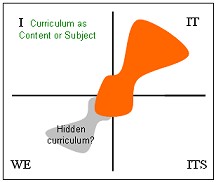 Curriculum as Content or Subjects:
Curriculum as Content or Subjects: This metaphor portrays a traditional image of curriculum that stretches back to Pythagoras and Plato. This curriculum is one which receives contents from traditional academic disciplines and transmits them to the learner.
Intent: Curriculum development centres largely on subjects, contents, timetables and booklists. Needs may be defined in terms of preparation for university, commerce or general study.
Criticism: Does not account for cognitive development, creative expression, and personal growth. Nor for planned and un-planned activities that are a major part of students’ experiences at school.
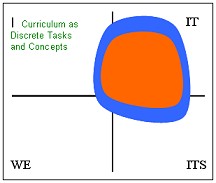 Curriculum as Discrete Tasks and Concepts:
Curriculum as Discrete Tasks and Concepts: The curriculum is seen as a set of tasks to be mastered and is derived from training programs in business, industry and the military.
Intent: ‘Apprenticeship’ with an adult to gain certain knowledge and skills.
Criticism: Does not prepare the learner for a changing world. Suited to technical training rather than conceptual understanding.
 Curriculum as Experience:
Curriculum as Experience: This image of curriculum, following John Dewey, emphasizes experience rather than sets of activities. Learners select a learning experience according to its significance in their life.
Intent: With this notion of curriculum, the learners have a key role in curriculum process. Experiences are created as learners reflect on the learning process.
Criticism: Students’ involvement in planning and selecting the learning experiences is very idealistic - they may not be able to decide which is of significance and which is not. How do you implement this in a large school?
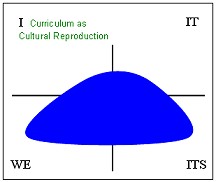 Curriculum as Cultural Reproduction:
Curriculum as Cultural Reproduction: The curriculum metaphor is concerned with the notion of transmission of cultural knowledge and values from one generation to another.
Intent: To prepare the youth for the culture of a certain community, state and country.
Criticism: Helps maintain the status quo by transmitting middle class culture rather than that of the oppressed. Does not help develop critical thinking.
 Curriculum as “Currere”:
Curriculum as “Currere”: The curriculum is the interpretation of the learner’s lived experiences – the learner comes to understand their past, how it drives the present and how it directs the future of their personal and professional life. Individuals come to a greater understanding of themselves, others, and the world about them.
Intent: Freedom from unwarranted convention, ideology and labelling. To mutually fashion new directions for oneself, others and the world.
Criticism: Self-understanding is a parental responsibility. The search for self-knowledge requires professional therapists.
 Curriculum as Intended Learning Outcomes:
Curriculum as Intended Learning Outcomes: This image sees the curriculum as a process of goal setting and drawing a pathways to those goals. The outcomes are expressed in general terms like “understanding the value of…”. Today most curriculum frameworks have incorporated this image.
Intent: The curriculum is explicit and defensible. Teachers and students can determine their learning activities according to their needs and locale.
Criticism: Draws attention away from unintended outcomes relating to school culture and the hidden curriculum.
So... how does one map curriculum as connectivism? At the moment my reading places it mainly in the ITS quadrant - grounded in an objective systemic worldview but taking into account issues of social constructivism (WE quadrant) with a span across blue/orange/green and possibly into yellow memes. A much broader span than the other metaphors...
 Curriculum as Connectivism:
Curriculum as Connectivism: This curriculum metaphor is related to networks and network topology. It takes a systems view of learners and sees learning as network creation.
Intent: To provide a ‘learning ecology’ that the student connects with as and when appropriate.
Criticism: Favours self-directed learners.
This is potentially a richer way of seeing curriculum provision and I'm now interested to see how this metaphor might inform our discussion of how students choose their learning, what structures we might put in place to provide learning ecologies and how we can support students to make the necessary connections... more on this later.
Our leadership team have already found Sieman's
Learning in Context powerpoint very useful (see also
this pdf paper) and I'm hoping to see him in Sydney later this year...
The above curriculum metaphors (apart from the last one) are sourced from: Schubert, W. H. (1986). Curriculum: Perspective, Paradigm, and Possibility. New York: Macmillan Publishing Company.Labels: conceptual frameworks, curriculum, integral
Holistic and Transformational Learning
The new Tasmanian Post Year 10 Curriculum Framework has just been released on CD. According to the overview document the Framework
"reflects an ‘holistic’ view of learners and learning with the experience of learning needing to extend beyond the informational to the transformational."

Our school curriculum team is now 6 months into planning for implementation. I thought I'd see if some of the current projects do indeed reflect an 'holistic' view and extend to the 'transformational'.
Project 1: New ICT Tools
This project is introducing a number of social software and presentation tools to students and teachers including blogs, podcasting, personal learning environments and digital story telling.
Do these tools enable holistic approaches to learners and learning? I think they could do... at least in the sense of students being able to express themselves through different media and teachers being able to have a fuller more inclusive view of the whole student.
Jack Miller defines holistic curriculum in terms of inclusiveness, connection and balance. Social software certainly provides connections from local to global levels and I think it can also give a better balance between Miller's tensions of individual/group, content/process and assessment/learning.
Do these tools enable transformation? Some describe these tools as "disruptive technologies" - I prefer the term 'transformational technologies' but I strongly agree. I think these tools can transform the relationship between learner and teacher, can transform how students access and undertake their own learning, and can transform a student's understanding of their place in the world.
Is it working? Still too early to tell... about 15% of teachers are now using at least one tool in their classes and feedback has been very positive but we have a long way to go. 10 copies of
Will Richardson's book (pictured) have been placed across the campus for teachers.
Project 2: Academic Achievement and Personal Enrichment
This project is providing support to a group of 60 students who are on traditional highly academic pathways. It aims to provide a learning space where students can learn together while at the same time challenging their assumptions and extending their involvement in 'non-academic' activities.
Holistic approach? Yes - this is an explicitly stated aim - to get these students to experience and express a more holistic sense of self including the physical, mental, social and spiritual.
Transformational? One part of the project that is well attended are sessions looking at enigma and anomalies (such as the evidence for advanced pre-historical civilizations) which attempts to question fundamental assumptions and worldviews based on
transformative learning theory.
Is it working? Early feedback from students would indicate that it is achieving these intended outcomes. One student wrote
"The Tuesday afternoons sessions have helped me to learn a lot about myself and others. I love learning about how people think, interact and learn. Knowing these things has changed the way I perceive myself, my education and others. I always leave the sessions deep in thought with the inspiration for further investigation."
Project 3: Lo-Tech Metal Fabrication

This project is providing safe and easy access to
metal work equipment for students across the college. The aim is to enable visual and performing arts students to integrate metal work into their projects without the need for training in welding and drilling.
Holistic approach? Not really... this is more about integrating skills from different subject areas.
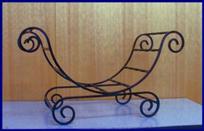 Transformational?
Transformational? One aim is to encourage more females to consider metal work so in this sense there may be an element of transformation of the perception of metal as a male only domain.
Is it working? This project is still being set up with the equipment that has just been purchased.
Project 4: Human Powered Vehicle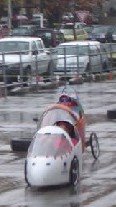
This project aims to design, build and race a three wheeled human-powered vehicle. Students from Material, Design and Technology will work with students from Physical Education to measure the vehicles performance and race it in
local and inter-state competitions.
Holistic approach? Yes in the sense that students will consider all aspects of this project and it will involve their physical, mental, emotional and social skills.
Transformational? This project aims to transform student attitudes to learning, empowerment and collaborative designing, making and appraising.
Is it working? Too early to tell - just in design stage...
Project 5: Integral Worldviews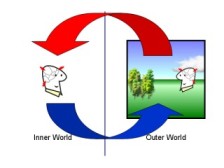
This project introduces students to aspects of
Integral Theory in an attempt to help them develop coherent conceptual frameworks that help them understand how values, assumptions and worldviews colour our perceptions.
Holistic Approach? Integral Theory by its very nature takes an holistic approach to human nature and knowledge.
Transformational? Students have reported that an integral approach does help them see things in new ways. Two students reported
"Openly challenged my way of thinking and what I personally believed in and accepted. Over-all very interesting and informative."
"Really insightful. Made me think life was more interesting… more to it."
Is it working? This project has been running for over a year and student feedback has been very positive.
Labels: holistic, ICT tools, integral, transformation
Games and Gaming in Education
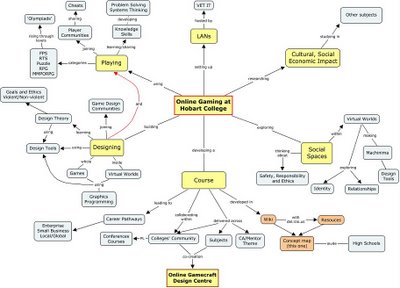
I've been having fun :-) A few teachers have been thinking about tapping into student interest in playing, socialising in, and designing online games. We have now committed to offering a game design course at Hobart College in 2007.
The reason I've been having fun is that I've put together my emerging understanding of concept mapping, blogs,
wikis and a recently discovered
audio blogging tool to see if we can collaboratively plan the new course with current and prospective students.
I've set up the above components on
my college blog and await the start of next term with anticipation... students are on vacation at the moment... I'm quite excited to see if I can get some real participation... I'm also hoping to use IM to add another dimension to any collaboration between schools.
In the meantime I thought I'd blog about it here to reach existing expertise and wisdom... :-)
For background reading and ideas to extend this project beyond just designing games I've ordered
Don't Bother Me Mom--I'm Learning! by Marc Prensky,
Why Video Games are Good for Your Soul by James Paul Gee and
3D Game-Based Filmmaking: The Art of Machinima by Paul Marino. The latter was inspired by reading about
machinima on Bud Hunt's
Bud the Teacher blog.
Let the games begin...
Labels: ICT tools, learning, teaching, video games

 I've spent the last week learning to build on a piece of land I've bought in SL. It's on an island in a region called Eldora - above the snowline. It cost me L$2,250 and I'm building a gallery to show off some of my wife's art work... I even managed to get a ball rotating :-)
I've spent the last week learning to build on a piece of land I've bought in SL. It's on an island in a region called Eldora - above the snowline. It cost me L$2,250 and I'm building a gallery to show off some of my wife's art work... I even managed to get a ball rotating :-)


















